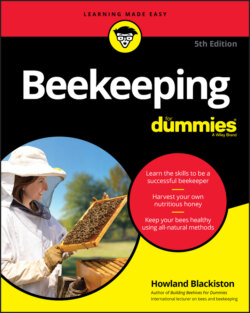Читать книгу Beekeeping For Dummies - Howland Blackiston - Страница 86
Knowing what makes a perfect bee yard
ОглавлениеThese girls are amazingly adaptable, but you’ll get optimum results and a more rewarding honey harvest if you follow some basic guidelines (see Figure 3-2). Basically, you’re looking for easy access (so you can tend to your hives), good drainage (so the bees don’t get wet), a nearby water source for the bees, dappled sunlight, and minimal wind. Keep in mind that fulfilling all these criteria may not be possible. Do the best you can by
Facing your hive to the southeast. That way your bees get an early morning wake-up call and start foraging early.
Positioning your hive so it is easily accessible come honey harvest time. You don’t want to be hauling hundreds of pounds of honey up a hill on a fiery hot day.
Providing a windbreak at the rear of the hive (see Figure 3-3). I’ve planted a few hemlocks behind my hives. Or you can erect a fence made from posts and burlap, blocking harsh winter winds that can stress the colony (assuming you live in a climate with cold winters).
Putting the hive in dappled sunlight. Ideally, avoid full sun because the warmth of the sun requires the colony to work hard to regulate the hive’s temperature on hot days. By contrast, you also want to avoid deep, dark shade because it can make the hive damp and the colony listless. On a city rooftop, fashion a burlap shade roof by stapling the material to four sturdy posts solidly planted in four 5-gallon buckets of cement. Or, fashion a small section of plywood, crank-strapped to and around the hive, to provide some shade for the girls.
Making sure the hive has good ventilation. Avoid placing it in a gully where the air is still and damp. Also, avoid putting it at the peak of a hill, should you live in a region where the bees will be subjected to winter’s cold fury.Courtesy of Howland BlackistonFIGURE 3-2: The picture-perfect bee yard. Not always possible, but an admirable objective.Courtesy of Howland BlackistonFIGURE 3-3: An ideal backyard location: hemlock windbreak; flat, easy access; dappled sunlight; southeastern exposure; and a nearby water source (not visible in this image).
Placing the hive absolutely level from side to side, and with the front of the hive just slightly lower than the rear (a difference of an inch or so is fine) so rainwater (and condensation from thousands of breathing bees) drains out of the hive (and not into it).
Mulching around the hive prevents grass and weeds from blocking its entrances.
Locating your hive on firm, dry land. Don’t let it sink into the quagmire. If you have doubts regarding the structure of your urban rooftop, check with the building maintenance crew. Don’t be famous for being the first urban beekeeper to fall through the roof and into someone’s apartment.
